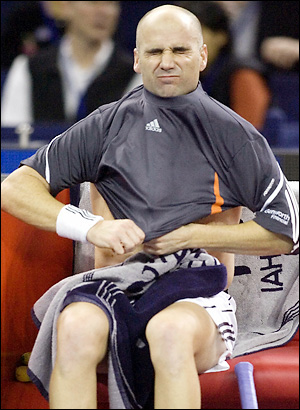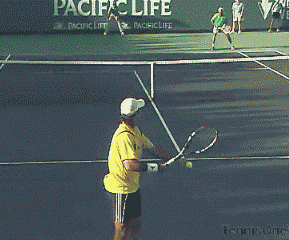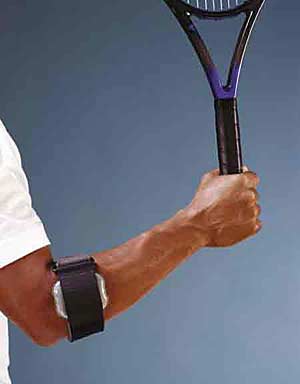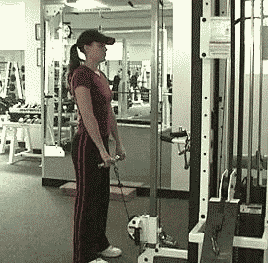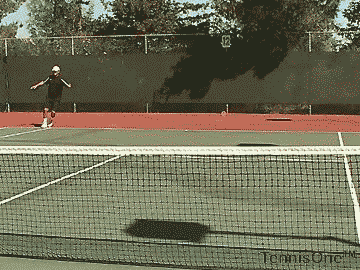|
TennisOne Lessons How to Play Tennis While Injured Dave Kensler - Peter Burwash International (PBI) It happens to everyone who plays sports. At some point you are going to be injured, perhaps due to the sport itself or for some other reason. Regardless, your ability to actively participate in the sport may be significantly curtailed or eliminated for some amount of time. So, what can you do if, even for just a few days, you cannot imagine your life without getting on a tennis court? Before exploring your options, let me clarify a few points:
When In Doubt Use "RICE" for a New Injury It is always a safe bet to adhere to the RICE( Rest, Ice, Compression and Elevation) approach for sprains, strains or other muscle or joint injuries. Proper care in the first day or two after injury can reduce the time you're sidelined by it. RICE can relieve pain, limit swelling and protect the injured tissue, all of which help to speed healing. Lets take a look at each of the RICE components.
Rest: This is vital towards protecting the injured muscle, tendon, ligament or other tissue from further damage. Your body needs to rest so it has the energy it needs to heal itself. It is important to remember you should never leave ice on an injury for more than 20 minutes at a time. Doing so for a longer period of time can damage your skin. If you need to have ice on for more than 20 minutes then do so in intervals...20 minutes on; 20 minutes off and so forth. Make Sure You Know Why You Were Injured If you are running for a shot, fall and sprain your ankle, it is obvious how you got hurt. However, if your injury is due to the way you hit the ball, then it would be worth getting a “diagnosis” from a teaching pro. Then, once you are properly healed, the injury will not repeat itself. Be aware that there is a difference between soreness and pain. If you experience pain when hitting a particular shot or making a certain move, then make an appointment with your physician. Pain can mean something more serious is going on. On the other hand, if you are experimenting with a new forehand and experience some soreness after the first day, it may be due to using new muscles. Rest for a few days and see how you feel. What to Do Before You Go On the Court There are various types of stretching, any of which depending on your injury, will be helpful prior to your even stepping on a tennis court. Stretching is an excellent preliminary effort even when you are healthy. Step 1: Take your time and hit any and all shots very slowly. The main purpose of warming-up in any sport is to prevent injury. Since you are already injured, make sure your warm-up is even more careful. Step 2: Warm-up one stroke at a time i.e. For example, hit only forehands for 5 minutes then move on to the next stroke. Rather than “jumping” all around from one stroke to another, which might further aggravate an injury, take one at a time.
Step 3: Proceed with caution when moving from groundstrokes to serve. Many tennis players injure themselves during this transition. Because they have hit ground strokes for a certain amount of time the feeling is they are “warmed up” so therefore serves can be blasted beginning with thefirst one. Yet the service motion is entirely different from the groundstrokes. Depending on the climate / temperature, you may choose to wear appropriate clothing and braces to keep an injured area warm and stabilized. To this point you have the necessary information from your physician, you have done your stretching and proper warm-up. Now let us take a look at common injury situations and your options: You Are Unable to Serve with Your Normal Overhand Motion? If it is a competitive league match or tournament, you may have to serve underhand. For a more social match, you may not need to serve at all! For example, if you are playing doubles, let your partner serve for you. Also regarding doubles, assuming you and your partner are both right-handed players, you may wish to return serve on the deuce court so your partner’s overhead smash is covering the middle area between the two of you. For singles, again, if it is not a league match or tournament, then you can still play points without the serve and return of serve. Just drop the ball and start the point with a groundstroke. Some serves can be particularly tough on the body. Over the years I have seen more than a fair share of tennis players with back problems due to body-bending efforts to hit a “kick serve.” You will not find much disagreement in the tennis teaching community that a “kick” or “twist” serve puts the most strain on your body. Therefore, a nice flat or slice serve will take much less effort. You may also consider hitting two second serves instead of your more powerful first serve. Mobility Issues
Generally speaking, playing singles will require more body twisting efforts than doubles due to the side-to-side movements during points. Most people find it easier to move forward, even if it only means walking, versus laterally with lots of turning. For the lobs which go over your head…Let them go! Moving back from the net to the baseline can often require sudden turns first to start moving back and then again to hit the ball. It is just one point in the match. By playing doubles you will hit fewer shots, serve only one-fourth of the time and have less of the court to cover compared to singles; therefore, in general, doubles will be less taxing on your body. Even in singles, if you decide to let many balls go, you will still be serving or returning serve on every point in the match. With doubles, your partner will be handling approximately half those shots. Which Ground Strokes To Use? Any time you impart spin on a ball it is going to take more racquet work to be successful. Although, with backspin, you can hit the shot with only 6 inches of racquet head movement i.e. A “chip” shot. Flat shots can only require a “blocking” motion. Topspin takes the most effort to hit. So you may wish to use your “block” or “chip” groundstrokes when playing with an injury which inhibits your ability to hit your normal topspin groundstrokes. Tennis Elbow?
If there are two words which send chills through the spine of every tennis player it would be, “tennis elbow.” For those who have had it, the pain can be enormous to the extent of not even being able to tie one’s shoelaces. For those who have not had it, count your blessings! Tennis elbow and its causes are an article by itself and have been written about in virtually every tennis publication. Unless it is caused by a non-tennis reason, like carrying too heavy a briefcase (one example I hear of often), then how you hit the ball is the source of the problem. So make sure you take a lesson from a teaching pro to find out which stroke(s) and how your hitting style is creating the elbow issues. If your tennis elbow is caused by your one-handed backhand, an almost instant “cure” is to switch to a two-handed backhand. This has been done either on a temporary or permanent basis by many tennis players over the years. The Mental Challenge When you cannot play your normal game, there is a good chance, in a competitive situation, you are going to lose and maybe even to people you would usually beat. Therefore, you probably need to change your expectations. First, put more emphasis on being happy just to be on a tennis court and playing. Second, be more selective in the type of competitive situations you get yourself into or whether your time on the tennis court even has to be competitive. Maybe just doing drills is a better option. Remember, you are injured. You may have to adjust your strokes and your mental approach to the game during this time frame. Returning to Tennis After an Injury? The players on the pro tour are the best example. A few years ago when Agassi was coming back from an injury he went out and played some Challenger events before returning to the main tour? If you are a 4.5 player, maybe it means getting into some 3.5 games where your opponent will not hit the ball as hard and you will not over extend yourself as you ease back into competition.
If your injury is being medically supervised then you should follow the instructions of your physician as to when you can return to playing tennis. However, often people try to come back too soon from an injury because they are feeling fine despite their physician wanting them to rest a few more weeks. Remember, it is a much different stress on the body to stand in one place and "feel fine" than it is to run around a tennis court hitting tennis balls. Learn To Play Tennis with Your Non-Dominant Arm! I have seen tennis players prolong their years on the court by learning to play tennis with their non-dominant arm due to a chronic shoulder or arm issue with their dominant arm. Likewise, I have also seen tennis players do the same with a temporary injury like coming off shoulder surgery to their dominant arm. If your goal is to play tennis, then get on the ball machine and hit with your non-dominant arm. If nothing else you will be guaranteed a few good laughs! Preventing Future Injuries
Poor Physical Conditioning: Participation in virtually any sport requires some level of physical conditioning to play well. You may need to get yourself in better shape. Remember, 95% of our body weight is ABOVE the knees, so if you are carrying some extra pounds and running around a tennis court, that is a lot of "pounding" on your joints! You would not walk out your front door and run a marathon without some training, so put some physical conditioning effort into your tennis game as well. I am always amazed at how many tennis players walk onto a court and start blasting ground strokes or serves. Why do basketball teams shoot lay-ups when they first come onto the floor? Not to practice lay-ups, which in all likelihood will result in fewer baskets during a game compared to other shots, but rather to start with some easy jogging towards the basket and shooting the ball a few feet from the goal. Remember, it's always wise to check with your physician when you have an injury but you have many options to play tennis even when you are injured. Keep it safe and simple. Your comments are welcome. Let us know what you think about Dave Kensler's article by emailing us here at TennisOne.
Dave Kensler has 23 years of teaching experience with Peter Burwash International (PBI), the most successful international tennis management company. PBI directs tennis programs at 60+ exclusive resorts and clubs in 23 countries and has taught over 3 million students in their 30 year history. For information on PBI tennis destinations and employment opportunities please go to www.pbitennis.com. All PBI Tennis Professionals play with WILSON racquets and wear WILSON shoes. |

